Etymology and Origin

The word “olive” originates from the Latin word “oliva,” which is derived from the Greek word “elaia.” The olive tree has a rich history, with its cultivation dating back to ancient times. Archaeological evidence suggests that olive trees were cultivated in the Mediterranean region as early as 8000 BC. The olive tree was a vital part of ancient Greek and Roman cultures, and its oil was used for cooking, lighting, and religious ceremonies.
Cultivation and Uses
Olive trees are evergreen trees that can grow to a height of 15 meters. They prefer well-drained soil and a warm, temperate climate. Olive trees are relatively easy to grow, and they can live for centuries. The olive tree’s fruit, the olive, is a small, oval-shaped fruit that is green when unripe and turns black when ripe. Olives are a good source of vitamins and minerals, and they are often used in cooking. Olive oil is a popular cooking oil, and it is also used in cosmetics and pharmaceuticals.
Culinary and Medicinal Uses
Olive definition – Olives have been a culinary and medicinal staple for centuries, offering a versatile range of applications. Their distinct flavor and nutritional value make them a beloved ingredient in various cuisines, while their health benefits contribute to their reputation as a natural remedy.
Culinary Applications
In cooking, olives add a savory and salty flavor to dishes. They are often used in salads, where their briny taste complements the freshness of greens and vegetables. Olives also find their place in sauces, stews, and casseroles, enhancing the overall depth of flavor. As a garnish, they provide a colorful and flavorful touch to pizzas, pasta dishes, and cheese platters.
Medicinal Properties
Olives are not only culinary delights but also possess remarkable medicinal properties. They are rich in antioxidants, including hydroxytyrosol and oleuropein, which protect cells from damage caused by free radicals. Olives also contain monounsaturated fats, which have been linked to reduced risk of heart disease, stroke, and certain types of cancer. Additionally, olives are a good source of vitamin E, iron, and fiber, making them a nutritious and health-promoting food.
Cultural and Symbolism: Olive Definition

Olives hold immense cultural and symbolic significance, deeply embedded in the history of various civilizations across the globe. From ancient Greece to modern-day Mediterranean cultures, olives have played a pivotal role in shaping traditions, beliefs, and artistic expressions.
The olive tree, with its evergreen foliage and bountiful fruit, has long been revered as a symbol of peace, fertility, and wisdom. In ancient Greece, the olive branch was a sacred emblem, representing the goddess Athena and symbolizing victory, peace, and reconciliation. It was often carried by messengers seeking to negotiate a truce or by victors in athletic competitions.
Religious Significance
Olives also hold deep religious significance in Christianity, Judaism, and Islam. In the Bible, the olive branch brought back by a dove to Noah after the Great Flood is a symbol of God’s covenant with humanity and a sign of hope and renewal. In Judaism, the olive tree is mentioned numerous times in the Torah and is associated with the menorah, the seven-branched candelabrum used in the Temple in Jerusalem.
Culinary and Medicinal Uses, Olive definition
Beyond their cultural and symbolic importance, olives have also been prized for their culinary and medicinal properties. The fruit of the olive tree is a versatile ingredient, used in various cuisines around the world. Olives can be eaten fresh, cured, or pressed into oil, which is a staple in Mediterranean cooking. Olive oil has also been used for centuries for its medicinal properties, including its anti-inflammatory and antioxidant effects.
Olives, with their distinct green hues and pungent flavor, have long been a culinary staple. Like the reels of a slot machine , their oil, once extracted, becomes a versatile ingredient, adding a rich and savory note to dishes. Yet, olives themselves remain an enigma, their enigmatic origins shrouded in the mists of time, much like the secrets hidden within the spinning symbols of a slot machine.
In the Mediterranean, where the olive tree thrives, its fruit has been a culinary staple for centuries. The olive’s versatility extends beyond the kitchen, as it also holds symbolic significance in various cultures. From the olive branch as a symbol of peace to the channel through which divine messages are said to flow, the olive tree’s multifaceted nature continues to inspire and captivate.
The olive, a fruit of the olive tree, is known for its versatility in cooking and its health benefits. Its distinct flavor and aroma have made it a culinary staple for centuries. From its use in Mediterranean cuisine to its role in traditional medicine, the olive has a rich history and cultural significance.
For more insights into the world of olives, explore the nyt connections database, which provides a comprehensive overview of the olive’s culinary, historical, and cultural aspects.
The olive, a fruit of the Mediterranean, is known for its rich flavor and versatility in cuisine. Its definition goes beyond culinary delights, as it has also been associated with symbolism and mythology. From ancient times, the olive tree has represented peace, wisdom, and abundance.
Like the olive, the tomorrow pit holds a similar significance, embodying the hope and potential of the future. Yet, the olive remains a staple in our present, reminding us of the enduring connections between our past, present, and the promise of tomorrow.
The olive tree, with its gnarled trunk and silvery leaves, is a symbol of peace and abundance. But it also has a darker side. The olive’s wood is hard and durable, making it an ideal material for sword handles. In the hands of a skilled warrior, an olive-handled sword could be a deadly weapon.
But even in peacetime, the olive tree’s wood is used for making furniture, bowls, and other objects of beauty.